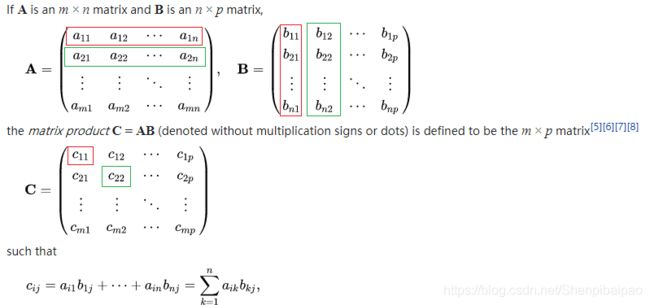Keras入门笔记(番一):从源码分析K.batch_dot及与dot的区别
动机
矩阵和向量的乘法各种名称都有,甚至相互混杂,在不同框架里的命名也不一样,每每都会陷入这些Magic中。例如,同样是dot对向量shape= (n,)和一维张量shape=(n,1)而言都不一样,无论总结过多少次,像我们这种torch和tensowflow、matlab轮着写的人,总是不经意间就会翻车。
好在keras提供了高级的接口,至少在tensorflow、theano以及可能会有的mxnet上的表现是一致的。
各种向量乘法的命名
我个人非常烦什么“点积、外积、内积、点乘、叉乘、直积、向量积、张量积”的说法,乱的不行。我觉得,还是应该统一一下,别一会儿点积一会儿点乘,二维一维都不区分,非常容易乱。由于中文教材各种翻译都有,因此主要还是用wiki作为统一吧。
一维(向量)
- 需要注意的是,
shape=(n, )的才是一维向量,shape(n,1)已经变成张量了。
import numpy as np
a = np.array([1,2,3,4,5]) # 向量,不区分列向量或行向量。应该视为列向量。
b = a.reshape((5,1)) # 张量
print(a.shape, b.shape, a.T.shape) # (5,) (5, 1) (5,)
print((a+b).shape) # (5, 5)
print(np.dot(a,a), a*a) # 55 [1 4 9 16 25]
print(np.dot(b.T,b)) # [[55]]
# Also, a*a = np.multiply(a, a), b*b = np.multiply(b, b)
- Cross product
构建神经网络时基本不用,仅在工程优化中大量使用,如共轭梯度等。API一般为
cross(a, b)。
- element-wise
逐元素乘法,也就是 Dot product 不进行求和: c i = a i b i c_i=a_ib_i ci=aibi。API一般为
multiply(a, b)
二维(矩阵)
- Hadamard product
常说的对应元素逐元素相乘。也是element-wise的一种。API一般是
multiply(a, b)。
- Matrix multiplication
就是线代中的矩阵乘法。一般也由
dot(a, b)或matmul(a, b)实现。
三维以上(高维张量)
Tensor product
由于涉及到群和多重线性代数,Tensor product不是太好表示,看wiki即可。
简单区分dot与matmul
keras.dot实际上并不进行实际的计算,只是在matmul上加了一层封装,用于适配一维dot product和稀疏向量计算时的优化,对nD张量进行相乘的规则进行补充。直接读源码:
if ndim(x) is not None and (ndim(x) > 2 or ndim(y) > 2):
# 对`nD`张量进行相乘的规则进行补充
# 同时适配x y 维度不一致的情况
# 即: x的最后一个维度与y的最后一个维度应当相同,这两个维度的元素进行dot product
# 例如 a.shape = (5, 6) b.shape=(8, 6, 3) => dot(a,b).shape=(5, 8, 3)
# 其在xy的最后两个维度上的表现,就如同二维Matrix multiplication一样。
x_shape = []
for i, s in zip(int_shape(x), tf.unstack(tf.shape(x))):
if i is not None:
x_shape.append(i)
else:
x_shape.append(s)
x_shape = tuple(x_shape)
y_shape = []
for i, s in zip(int_shape(y), tf.unstack(tf.shape(y))):
if i is not None:
y_shape.append(i)
else:
y_shape.append(s)
y_shape = tuple(y_shape)
y_permute_dim = list(range(ndim(y)))
y_permute_dim = [y_permute_dim.pop(-2)] + y_permute_dim
xt = tf.reshape(x, [-1, x_shape[-1]])
yt = tf.reshape(tf.transpose(y, perm=y_permute_dim), [y_shape[-2], -1])
return tf.reshape(tf.matmul(xt, yt),
x_shape[:-1] + y_shape[:-2] + y_shape[-1:])
# 在2维和低维情况下
if is_sparse(x):
out = tf.sparse_tensor_dense_matmul(x, y)
else:
out = tf.matmul(x, y)
return out
keras.batch_dot函数源码分析
虽然这个函数中带有一个dot,然而其和dot没有太大关联。其更多的是一种可自定义维度的element-wise算法,注重的是对深度学习中的维度规则进行了优化:往往第一个维度是批样本的batch_size,非常适用于计算诸如 ∑ i a i j b j ∣ i \sum_i{ a_{ij}b_{j|i}} ∑iaijbj∣i的场景。
源码分为两个部分,第一个部分:
# axes 对应了x, y向量中分别准备进行dot product的维度
if isinstance(axes, int):
axes = (axes, axes)
x_ndim = ndim(x)
y_ndim = ndim(y)
if axes is None:
# behaves like tf.batch_matmul as default
axes = [x_ndim - 1, y_ndim - 2]
if py_any([isinstance(a, (list, tuple)) for a in axes]):
raise ValueError('Multiple target dimensions are not supported. ' +
'Expected: None, int, (int, int), ' +
'Provided: ' + str(axes))
# 将二者补齐维度,补为1维
if x_ndim > y_ndim:
diff = x_ndim - y_ndim
y = tf.reshape(y, tf.concat([tf.shape(y), [1] * (diff)], axis=0))
elif y_ndim > x_ndim:
diff = y_ndim - x_ndim
x = tf.reshape(x, tf.concat([tf.shape(x), [1] * (diff)], axis=0))
else:
diff = 0
接着是第二部分,主要涉及了补充了计算的逻辑:
if ndim(x) == 2 and ndim(y) == 2:
# 如果都是二维矩阵,则效果等同于直接计算二者矩阵乘积的对角线上的值
# (实际上是 x y 进行hadamard product,然后在相应维度axes[0]、axes[1]上进行求和)
if axes[0] == axes[1]:
out = tf.reduce_sum(tf.multiply(x, y), axes[0])
else:
out = tf.reduce_sum(tf.multiply(tf.transpose(x, [1, 0]), y), axes[1])
else:
# 不都是二维矩阵的话,进行矩阵计算
if axes is not None:
# 判断是否要进行共轭和转置
# 需要注意的是它并不对axes[0]的值进行传递而只是检测
# 这是一个比较magic的诡点,所以axes[1, 1] 可能会和[1000, 1000]的结果是一样的
adj_x = None if axes[0] == ndim(x) - 1 else True
adj_y = True if axes[1] == ndim(y) - 1 else None
else:
adj_x = None
adj_y = None
# 这个计算比较精髓,涉及到线代知识。总之其效果是,给定的轴hadamard product然后求和
# 同维度情况下,对最后两维进行矩阵乘法,axes不起作用
out = tf.matmul(x, y, adjoint_a=adj_x, adjoint_b=adj_y)
if diff:
# 在不是同维矩阵的情况下,
if x_ndim > y_ndim:
idx = x_ndim + y_ndim - 3 # (x_ndim-1+y_ndim-1) -1 二者总维度的序-1
else:
idx = x_ndim - 1
# x_ndim较大的情况下,多余的维度全部挤压,保证输出维度只有x_dim+y_dim-2
# 否则输出维度为x_ndim
out = tf.squeeze(out, list(range(idx, idx + diff)))
if ndim(out) == 1:
# 扩充维度以保证输出维度不为1
out = expand_dims(out, 1)
return out
坑:magic分析
对于所提到的magic,举一个例子:
a = K.ones([100, 10, 16, 5])
b = K.ones([100, 10, 16, 9])
with tf.Session() as sess:
print(K.batch_dot(a, b, axes=[2, 2]).shape) # (100, 10, 5, 9)
print(K.batch_dot(a, b, axes=[100, 1000]).shape) # (100, 10, 5, 9)
# 分析以上结果
# 1.axes[0]都非x最后一维,x共轭转置;
# 2.axes[1]都非y最后一维,y不共轭转置。
# 3.消掉最后一个相同的维度
另一段代码:
a = K.ones([100, 10, 16, 5])
b = K.ones([100, 10, 9, 16])
with tf.Session() as sess:
print(K.batch_dot(a, b, axes=[2, 3]).shape)
# 分析以上结果
# 1.axes[0]不是x最后一维,x共轭转置;
# 2.axes[1]是y最后一维,y共轭转置。
# 3.消掉分别标注的维度



